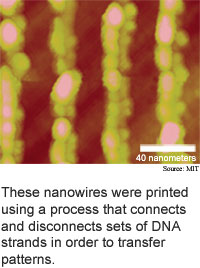
DNA
process stamps patterns
Many researchers are tapping
DNA's ability to spontaneously assemble in order to make objects on the
molecular scale.
Researchers from the Massachusetts Institute of Technology and
Virginia Commonwealth University have devised a way to stamp patterns
made of single-stranded DNA molecules onto a surface. The method also
makes it possible to convert patterns composed of other material into
DNA.
The method could be used to print microarrays of DNA that can
be used for medical research and diagnosis. It could also be used to print
many types of devices, including tiny channels that shunt fluids around
biochips, optical biosensors and transistors, according to the researchers.
One of the main challenges of nanotechnology is developing methods
of making objects in parallel to enable mass production. One of the advantages
of the researchers' stamping method is that each pattern produced by a
stamp can, in turn, be used as a stamp.
The technique can transfer patterns whose features are as small
as 30 nanometers. A nanometer is one millionth of a millimeter, or the
span of 10 hydrogen atoms. The researchers used the method to stamp lines,
circles and squares.
To make a stamp, the researchers used lithography -- etching using
light and chemicals -- to produce a master copy of the pattern, then chemically
attached a set of DNA strands to it. They then attached another set of
DNA strands to the first set, attached the chemically-modified ends of
those strands to a surface, and detached the second set of DNA strands
from the first to produce the stamped pattern.
In theory, the method will work with any pairs of molecules that
recognize and attach to each other, then can be detached, including antibodies
and antigens, according to the researchers. The stamped patterns can also
be modified. The researchers added metal and fluorescent molecules to
some of their prototype stamp patterns.
The work appeared in the June 13, 2005 issue of Nano Letters
(Supramolecular Nanostamping: Using DNA as Movable Type).
Stories:
System carries PC soul
Letter: a short history of TRN
Plug-in protects passwords
Ice transforms chipmaking
Pixels speed quantum crypto
Briefs:
Textures ID paper and plastic
DNA process stamps patterns
Templates yield nano branches
Chemistry moves micro machines

Research Watch blog
View from the High Ground Q&A
How It Works
RSS Feeds:
News
Ad links:
Buy an ad link
Ad links: Clear History
Buy an ad link
|
TRN
Newswire and Headline Feeds for Web sites
|
© Copyright Technology Research News, LLC 2000-2010. All rights reserved.